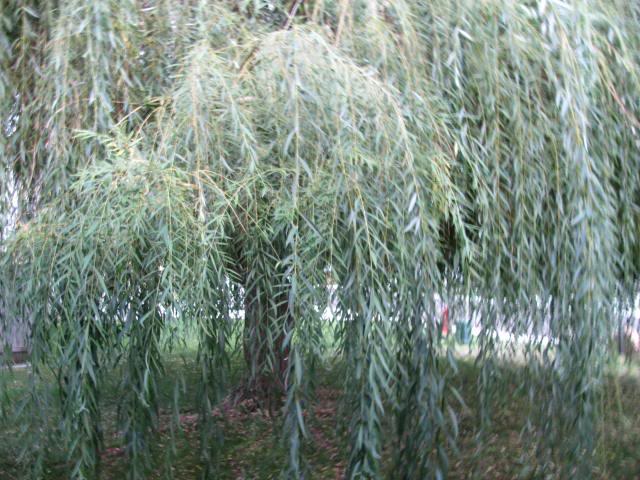Acute Willow Tree Biography
Willows all have abundant, watery bark, sap which is heavily charged with salicylic acid, soft, usually pliant, tough wood, slender branches, and large, fibrous, often stoloniferous roots. The roots are remarkable for their toughness, size, and tenacity to life, and roots readily grow from aerial parts of the plant.
The leaves are typically elongated, but may also be round to oval, frequently with a serrated margin. Most species are deciduous; semi-evergreen willows; coriaceous leaves are rare, e.g. Salix micans and S. australior in the eastern Mediterranean. All the buds are lateral; no absolutely terminal bud is ever formed. The buds are covered by a single scale, enclosing at its base two minute, opposite buds, alternately arranged, with two small, opposite, scale-like leaves. This first pair soon falls, and the later leaves are alternately arranged. The leaves are simple, feather-veined, and typically linear-lanceolate. Usually they are serrate, rounded at base, acute or acuminate. The leaf petioles are short, the stipules often very conspicuous, look like tiny, round leaves and sometimes remain for half the summer. On some species, however, they are small, inconspicuous, and fugacious (soon falling). In color, the leaves show a great variety of greens, ranging from yellowish to bluish.
Willows are dioecious, with male and female flowers appearing as catkins on different plants; the catkins are produced early in the spring, often before the leaves, or as the new leaves open.
The staminate (male) flowers are without either calyx or corolla; they consist simply of stamens, varying in number from two to ten, accompanied by a nectariferous gland and inserted on the base of a scale which is itself borne on the rachis of a drooping raceme called a catkin, or ament. This scale is square, entire and very hairy. The anthers are rose-colored in the bud, but orange or purple after the flower opens, they are two-celled and the cells open longitudinally. The filaments are threadlike, usually pale Brown, and often bald.
The pistillate (female) flowers are also without calyx or corolla, and consist of a single ovary accompanied by a small, flat nectar gland and inserted on the base of a scale which is likewise borne on the rachis of a catkin. The ovary is one-celled, the style two-lobed, and the ovules numerous.
Willows all have abundant, watery bark, sap which is heavily charged with salicylic acid, soft, usually pliant, tough wood, slender branches, and large, fibrous, often stoloniferous roots. The roots are remarkable for their toughness, size, and tenacity to life, and roots readily grow from aerial parts of the plant.
The leaves are typically elongated, but may also be round to oval, frequently with a serrated margin. Most species are deciduous; semi-evergreen willows; coriaceous leaves are rare, e.g. Salix micans and S. australior in the eastern Mediterranean. All the buds are lateral; no absolutely terminal bud is ever formed. The buds are covered by a single scale, enclosing at its base two minute, opposite buds, alternately arranged, with two small, opposite, scale-like leaves. This first pair soon falls, and the later leaves are alternately arranged. The leaves are simple, feather-veined, and typically linear-lanceolate. Usually they are serrate, rounded at base, acute or acuminate. The leaf petioles are short, the stipules often very conspicuous, look like tiny, round leaves and sometimes remain for half the summer. On some species, however, they are small, inconspicuous, and fugacious (soon falling). In color, the leaves show a great variety of greens, ranging from yellowish to bluish.
Willows are dioecious, with male and female flowers appearing as catkins on different plants; the catkins are produced early in the spring, often before the leaves, or as the new leaves open.
The staminate (male) flowers are without either calyx or corolla; they consist simply of stamens, varying in number from two to ten, accompanied by a nectariferous gland and inserted on the base of a scale which is itself borne on the rachis of a drooping raceme called a catkin, or ament. This scale is square, entire and very hairy. The anthers are rose-colored in the bud, but orange or purple after the flower opens, they are two-celled and the cells open longitudinally. The filaments are threadlike, usually pale Brown, and often bald.
The pistillate (female) flowers are also without calyx or corolla, and consist of a single ovary accompanied by a small, flat nectar gland and inserted on the base of a scale which is likewise borne on the rachis of a catkin. The ovary is one-celled, the style two-lobed, and the ovules numerous.
Acute Willow Tree
Acute Willow Tree
Acute Willow Tree
Acute Willow Tree
Acute Willow Tree
Acute Willow Tree
Acute Willow Tree
Acute Willow Tree
Weeping Willow Tree
The Willow Tree







No comments:
Post a Comment